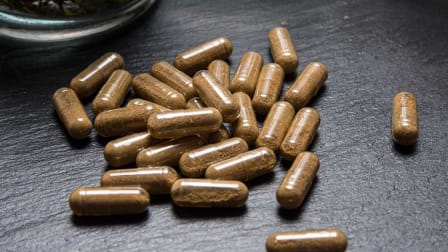How to Track Your Health at Home
Blood pressure monitor? Fitness tracker? Cholesterol tests? Here's what you need and what you can skip.
When you shop through retailer links on our site, we may earn affiliate commissions. 100% of the fees we collect are used to support our nonprofit mission. Learn more.

Nearly one-third of Americans do not have a primary care provider, a number that has been on the rise for years. Even if you do have a regular doctor, it may be difficult to get in to see them when you want.
According to a survey of 15 metropolitan areas in the U.S., wait times for a doctor’s appointment are significantly longer now than they have been at any point since the survey began 20 years ago. This can make it more challenging for you to be clear on the state of your health—and to get any potential issues addressed before they escalate.
On the upside, there are a growing number of ways to monitor your health yourself between doctors’ appointments, says Jeffrey Kullgren, MD, an associate professor in the department of internal medicine at the University of Michigan Medical School in Ann Arbor. While you may already have a first-aid kit, consider adding a few items to it, notably those that will allow you to track your blood pressure, temperature, heart rate, weight, and more without leaving home.
4 Helpful Devices
Experts weigh in on choosing and using these effective self-assessment tools. Plus, see some of the top picks from CR’s rigorous tests.
Blood Pressure Monitor
This allows people to track their blood pressure at home. That’s useful because almost half of U.S. adults—nearly 120 million people—have high blood pressure, according to the Centers for Disease Control and Prevention. And only about a quarter of them have the condition under control. Hypertension means your systolic (top) number is 130 mmHg or higher, and your diastolic (bottom) number is 80 mmHg or higher. Anything over 120 mmHg systolic is considered prehypertension.
Who it’s useful for: A home blood pressure monitor is a must for anyone with high blood pressure and is worth considering for people with prehypertension, too, says cardiologist Nieca Goldberg, MD, a clinical associate professor of medicine at the NYU Grossman School of Medicine in New York City. It can help you get more accurate and consistent blood pressure readings than in a doctor’s office, and lets you see how your blood pressure changes in response to lifestyle changes or medications.
For best results: Take your blood pressure twice daily, at the same time of day, Goldberg says. Each time, take two to three readings, a minute or two apart. Use an arm-cuff monitor if possible. (Our tests have found that they’re more reliable than wrist cuff models.) Don’t smoke, exercise, or consume caffeine or alcohol for 30 minutes beforehand; use the bathroom and rest quietly for at least 5 minutes. Then sit with your back straight and supported on a hard chair, feet flat on the floor. Your arm should also be supported on a flat surface, such as a table, with your upper arm at heart level. "Record all of your results and bring them to your next doctor visit," Goldberg says, to help inform your treatment.
Thermometer
An old standby for kids, this device is critical for adults, too: Whenever you don’t feel well, it’s helpful to know if a fever has set in—and how high it is, says Michael Hochman, MD, MPH, a Los Angeles internist. If a fever lasts for more than three days or rises above 104° F, see your doctor.
Who it’s useful for: Everyone. And it’s a good idea to take your temperature a couple of times when you’re not sick, to determine your personal baseline. A study published last year in JAMA found that normal temperatures range anywhere from 97.2 to 98.4° F, with an overall average of 97.9° F. A note: Temperatures tend to be lowest in the early morning, and highest around 4 in the afternoon.
For best results: If you have a fever, Hochman recommends that you take your temperature twice daily to get a clear picture: once in the morning, and once in the evening. A 2021 study published in the journal Biology tested seven thermometer types and found that the in-ear thermometer, which uses an infrared sensor to measure the temperature inside your ear canal, was the most accurate. CR tests these for accuracy, consistency, and more.
Fitness Tracker
A fitness tracker uses sensors to gather data about your physical activity and usually syncs wirelessly with a smartphone app. These range from simple clip-on devices to expensive watches with high-definition screens.
Who it’s useful for: Anyone who wants to know more about how much exercise they’re actually getting, or who is trying to increase their activity level. (Aim for at least 150 minutes of moderate-intensity or 75 minutes of high-intensity activity per week, along with two muscle-strengthening workouts.) "Many also have the ability to track changes in your heart rate, which is a good way to see if you are improving in your fitness levels," says Cedric Bryant, PhD, president and chief science officer of the American Council on Exercise.
For best results: To stay in the know on your activity levels, you’ll need to have a fitness tracker with you any time you’re on the move—and if you don’t want an extra device, check your smartphone or smartwatch to see if it has the functions you’re seeking. (These may be found in an Apple Health, Google Fit, or Samsung Health app.) For many people, a fitness tracker or smartphone that only counts steps or minutes of activity may be sufficient. And with either, you can typically set and easily change your goals for steps, length of activity, distance, or stairs climbed per day. For heart rate data, what trackers provide is often an estimate. So they’re best used as a way of monitoring changes in your fitness level, Bryant says. (CR’s fitness tracker ratings include an assessment of heart rate monitoring accuracy.)
Bathroom Scale
Some scales simply tell you how much you weigh, which is generally enough information for most people. But so-called smart scales may also calculate the percentage of your weight that comes from fat or your body mass index, or BMI—a weight measure that has drawn criticism recently. Among other issues, BMI doesn’t distinguish among muscle, fat, and bone mass, so it might not provide much insight.
Who it’s useful for: People who are trying to lose or maintain weight may be the primary users of bathroom scales. But these increasingly sleek tools are also essential for anyone with heart failure, because even small changes in weight can be an important warning sign of related problems, such as fluid retention. For weight loss, some research finds that people who get on the scale daily are more successful than those who do so only once or a few times a week. "It’s one of the most useful tools in weight management there is," says Kullgren at the University of Michigan Medical School. Other research suggests that weighing yourself regularly may lead to unhealthy eating habits.
For best results: Weighing yourself first thing in the morning tends to be most accurate because you haven’t had anything to eat or drink overnight, Kullgren says. Some fluctuation is normal. If you have heart failure and gain more than 2 or 3 pounds in a 24-hour period, or more than 5 pounds in a week, it may be because of fluid retention. Unexpected weight loss in people with heart failure could be a sign that the condition has progressed. In either case, notify your doctor.
Also Worth Considering
Want more health-tracking options in your toolbox? Here are a few others you might find helpful.
Online Hearing Test
This can be useful for anyone who wants to get a general sense of their hearing ability, says Catherine Palmer, PhD, director of audiology at the University of Pittsburgh Medical Center. You can take one such test in an app from the World Health Organization; search for hearWHO in your app store. (Read more about home hearing tests.)
Dynamometer
This handheld tool lets you do a grip-strength test, a good gauge of overall muscle strength for adults over 65. A healthy minimum squeeze in older adults is about 73 pounds for men, and 44 for women. If yours is below that, ask your doctor about a strength training plan or physical therapy.
Blood Glucose Monitor
Using a drop of blood, this device can check your blood sugar level. Glucose monitors are essential for people who use insulin, and very helpful for tracking how those with diabetes and prediabetes respond to certain foods. They’ve also been marketed to people without diabetes, but no research shows that they’re beneficial for this group, says Steven Furr, MD, president of the American Academy of Family Physicians.
Cardio Machine
Anyone who wants to track their fitness level during their workout may find a treadmill or an exercise bike useful. These can typically determine your heart rate during a workout, an important metric of your overall physical health. Ideally, use a machine with a chest strap heart rate monitor (see two such machines below), rather than handgrip sensors, which tend to be less accurate.
"Over time, as you become more fit, your heart rate should begin to gradually decrease," says Cedric Bryant, PhD, at the American Council on Exercise. Pay attention to how easily you can breathe while exercising; any increase in your shortness of breath without an increase in your usual intensity warrants a call to the doctor. Any chest pain could signal it’s time for a heart workup.
But You Can Skip These
Some tests or devices that sound like they could be helpful might not actually provide you with information that’s useful.
Sleep Tracker
Various apps and gadgets let you measure everything from sleep duration and sleep quality to snoring. But a 2019 review questioned the accuracy of these devices. Research also suggests they can stress you out and make it harder to sleep. "I have seen a lot of worry from them," says Hochman, the Los Angeles internist. "They’re supposed to motivate you to adopt better sleep habits, not cause anxiety."
Cholesterol Test
These home blood tests measure what’s called total cholesterol. Some also check levels of your HDL ("good") cholesterol and triglycerides, a type of fat found in your blood. They can be about as accurate as the test your doctor uses, according to the Food and Drug Administration. (They do vary from brand to brand, so the FDA recommends checking the accuracy listed on a test’s package.) But most of the time it simply doesn’t make sense to do this test at home. Unlike a home test, a doctor-ordered cholesterol test is usually covered by insurance, says Goldberg at the NYU Grossman School of Medicine, and you’ll need to go over the results with your doctor anyway.
Menopause Test
At-home hormone tests can check either your urine—for levels of a reproductive hormone called FSH—or your blood, for levels of other female hormones, such as estradiol. But "they only measure hormones in one snapshot of time," Furr says. "When you’re going through menopause, your hormones may be all over the place. You won’t get an accurate picture." Plus, you can work with your doctor on potential treatments based on your symptoms alone.
Genetic Test
These saliva tests are sometimes marketed as a way to assess your risk of Alzheimer’s disease, cancer, and more. But most are not regulated by the FDA, so you might not be able to trust the findings. And some offer results only about gene variants common in specific ethnic groups—so depending on your background, they may be worthless for you, says Joy Larsen Haidle, MS, past president of the National Society of Genetic Counselors. The tests can also provide a false sense of security—or propel you into an unnecessary state of alarm. Plus, there are significant privacy concerns when you send your saliva off in the mail; you might not know where or how your data is used. Such testing needs to be done with a genetic counselor, to help you properly interpret results, Haidle says. (Read about the privacy problems of direct-to-consumer genetic testing.)
How Often Should You See a Doctor?
An annual physical is often touted as crucial. But do you need one? A 2021 review published in JAMA found that while general health checks weren’t associated with lower rates of death, heart attack, stroke, or cardiovascular disease, there were some clear benefits. Annual checkups were associated with increased detection of issues such as depression and high blood pressure, greater use of important screening tests for conditions such as colon or cervical cancer, and better quality of life.
Regular check-ins, even if not quite annual, are "a way for you and your doctor to catch up on your health history in a more relaxed setting," says Michael Hochman, MD, MPH, a Los Angeles internist. It’s also a good time to make sure you’re up to date on health screenings and vaccinations. "You can ward off a slew of problems—including costly, time-consuming medical visits—further down the road," Hochman says.
If you’re under age 50, with no underlying medical conditions, guidelines don’t say you have to see a doctor annually. But if you’re 50 or older, it may be unwise to skip that yearly exam. And if you take any meds or have a chronic issue such as high blood pressure, elevated cholesterol, or type 2 diabetes, you really need an annual checkup, says Steven Furr, MD, president of the American Academy of Family Physicians. Most likely, you’ll need to be seen two or three times a year.
Editor’s Note: This article also appeared in the May/June 2024 issue of Consumer Reports magazine.




















